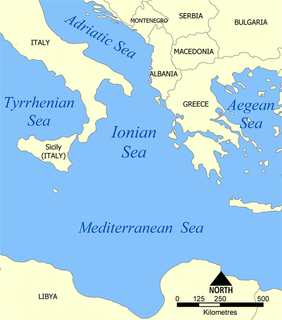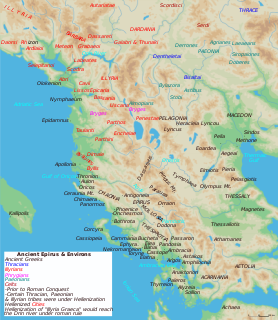
The Ionian Sea is an elongated bay of the Mediterranean Sea, south of the Adriatic Sea. It is bounded by Southern Italy including Calabria, Sicily, and the Salento peninsula to the west, southern Albania to the north, and the west coast of Greece.

Acarnania is a region of west-central Greece that lies along the Ionian Sea, west of Aetolia, with the Achelous River for a boundary, and north of the gulf of Calydon, which is the entrance to the Gulf of Corinth. Today it forms the western part of the regional unit of Aetolia-Acarnania. The capital and principal city in ancient times was Stratos. The north side of Acarnania of the Corinthian Gulf was considered part of the region of Epirus.
Philoxenus or Philoxenos is the name of several prominent ancient Greeks:

The Ionian Islands are a group of islands in Greece. They are traditionally called the Heptanese, i.e. "the Seven Islands", but the group includes many smaller islands as well as the seven principal ones.
The Leleges were an aboriginal people of the Aegean region, before the Greeks arrived. They were distinct from another pre-Hellenic people of the region, the Pelasgians. The exact areas to which they were native are uncertain, since they were apparently pre-literate and the only references to them are in ancient Greek sources. These references are casual and sometimes fictitious. Likewise, little is known about the language of the Leleges.
Phlegra is both a real and a mythical location in both Greek and Roman mythology.

Salento is a geographic region at the southern end of the administrative region of Apulia in Southern Italy. It is a sub-peninsula of the Italian Peninsula, sometimes described as the "heel" of the Italian "boot".

The Gulf of Taranto is a gulf of the Ionian Sea, in Southern Italy.

The Messapians were a Iapygian tribe that inhabited Salento in classical antiquity. Two other Iapygian tribes, the Peucetians and the Daunians, inhabited central and northern Apulia respectively. All three tribes spoke the Messapian language, but had developed separate archaeological cultures by the seventh century BC. The Messapians lived in the eponymous region Messapia, which extended from Leuca in the southeast to Kailia and Egnatia in the northwest, covering most of the Salento peninsula. This region includes the Province of Lecce and parts of the provinces of Brindisi and Taranto today.
Santa Maria di Leuca, often spelled simply Leuca, is a frazione of the comune of Castrignano del Capo, in the province of Lecce (Apulia), southern Italy.
A part of the town once belonged to the comune of Gagliano del Capo.
Punta di Pellaro is the extreme southwestern point of mainland Italy, in the region of Calabria, looking towards the east coast of Sicily, at 38°01′N 15°38′E.

Palairos is an ancient city and a modern town in Aetolia-Acarnania, Greece. Since the 2011 local government reform Palairos is part of the municipality Aktio-Vonitsa, of which it is a municipal unit. The municipal unit has an area of 205.843 km2. The municipal unit was formed as the independent municipality Kekropia in 1994 from the former communities Palairos and Pogonia, and was expanded with the former communities Vatos, Plagia and Peratia as a part of the 1997 Kapodistrias reform. The name was changed to Palairos in 2004.

Alyzeia or Alyzia (Ἀλυζια), was a town on the west coast of ancient Acarnania. According to Strabo it was distant 15 stadia from the sea, on which it possessed a harbour and a sanctuary, both dedicated to Heracles. In this sanctuary were some works of art by Lysippus, representing the Labours of Heracles, which a Roman general caused to be removed to Rome on account of the deserted state of the place. The remains of Alyzia are still visible in the valley of Kandili. The distance of the bay of Kandili from the ruins to Leucas corresponds with the 120 stadia which Cicero assigns for the distance between Alyzia and Leucas. Alyzia is said to have derived its name from Alyzeus, a son of Icarius. It is first mentioned by Thucydides; in 375 BCE, a naval battle was fought in the neighbourhood of Alyzia between the Athenians under Timotheus and the Lacedaemonians under Nicolochus. The Athenians, says Xenophon, erected their trophy at Alyzia, and the Lacedaemonians in the nearest islands. We learn from the Periplus of Pseudo-Scylax that the island immediately opposite Alyzia was called Carnus, the modern Kalamos.

Thyrium or Thyrion, or Thyreum or Thyreon (Θύρεον), or Thurium or Thourion (Θούριον), or Thyrreium or Thyrreion (Θύρρειον), was a city in ancient Acarnania. Cicero tells us that in sailing from Alyzia to Leucas, he touched at Thyrium, where he remained two hours; and from this statement, as well as from the history of the events in which Thyrium is mentioned, we may infer that it was situated on or near the Ionian Sea, and that it was the first town on the coast south of the channel which separated Leucas from the mainland.
Opson is an important category in Ancient Greek foodways.
First and foremost opson refers to a major division of ancient Greek food: the 'relish' that complements the sitos (σίτος) the staple part of the meal, i.e. wheat or barley.
Sollium or Sollion, was a town on the coast of ancient Acarnania, on the Ionian Sea. It was in the neighbourhood of Palaerus, which lay between Leucas and Alyzia. William Martin Leake, however, placed it south of Alyzia, at Stravolimióna. Sollium was a Corinthian colony, and as such was taken by the Athenians in the first year of the Peloponnesian War. The Athenians gave both the place and its territory to Palaerus. It is again mentioned in 426 BCE, as the place at which Demosthenes landed when he resolved to invade Aetolia.
Nericus or Nerikos, also known as Neritus or Neritos (Νήρῐτος), was a well-fortified town on the mainland of ancient Acarnania across from Leucas, mentioned by Homer in the Odyssey. In the middle of the seventh century BCE, the Corinthians, under Cypselus, founded a new town near the isthmus, which they called Leucas, where they settled 1000 of their citizens, and to which they removed the inhabitants of Nericus. The town must still have existed down to a much later date, as it is mentioned by Thucydides in the context of the Peloponnesian War. Thucydides writes that in the year 428 BCE, Athenian troops and Acarnanians under Asopius landed at Nericus, but many Leucadians came to the aid of the town, and Asopius died during the retreat. In Ovid's Metamorphoses, Macareus, a companion to Odysseus on his voyages, was from Nericus; Macareus was transformed into a pig by Circe.










